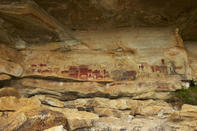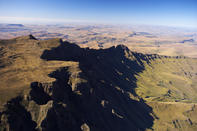Natural and Cultural Components
uKhahlamba-Drakensberg Park is one of two UNESCO World Heritage Sites in South Africa with a mixed classification - due to its natural and cultural components.

The natural elements include the Afro montane and Afro-alpine biological zones and, of course, the grand scenery. The cultural element is the San Rock Art that has been described as comprising the world's greatest outdoor art gallery. Some 20 000 individual images in more than 500 caves and shelters have been identified, with the greatest concentration of these being in and around Didima Gorge in the Cathedral Peak area of KwaZulu-Natal. Visits to rock art sites can only be done with a certified guide.
Rock Art Along The Escarpment

The Drakensberg Mountains — really an escarpment wall with no 'other side'— are lambasted by thunderstorms in summer, vicious enough to make a hardened sinner pray, and lashed by snowstorms in winter just like all good mountains should be. But what makes these hills so especially remarkable is a band of golden sandstone cliffs that acts as a plinth for the higher, fractured basalt crags.
They are packed with overhangs and caves that house one of the world's greatest art collections, the rock art of the San people who lived there for millennia until the last one was shot near Giant's Castle around 1900. Around his waist was a leather thong from which hung small antelope horns filled with pigments — the last great artist of a tradition that stretched back to the dawn of modern human life.
Drakensberg rock art is ‘a staging post in man’s long journey from the vast blackness of the silent past into the light of recorded history.’ - Lawrence Green
Giant Dinosaurs

At the time when the Drakensberg lavas were giving Southern Africa the biggest fireworks display it had ever seen, albeit to an unappreciative audience, giant dinosaurs still dominated the land. A Brachiosaurus fossil found in East Africa shows a leg bone about two metres long, with a joint as big as a large watermelon; its owner must have weighed as much as 100 tonnes.
But as vast streams of lava poured out of fissures in the ground, all the animal and plant life within reach was destroyed. Fossils were first recorded in the mid nineteenth century by the doyen of South African geology, Andrew Geddes Bain, who identified two general types: 'bidentals' and 'monsters'.
It was then generally believed that fossils were organic embryos of creatures that, in their struggle for life, had failed to free themselves from the elements that gave them birth. Different evolutionary stages were described as varying degrees of embryonic development within the rock.
Massive Outpourings of Lava

The high basalt walls of the Drakensberg were originally formed by massive outpourings of lava that brought the Karoo's Stormberg geological period to a close. The volcanic eruptions began about 180 million years ago and carried on successively for the next 30 million years or so, in the most spectacular pyrotechnical display the earth has experienced.
It formed a sheet of basalt covering most of the Karoo Basin, which at its thickest lay some 10 kilometres deep. During subsequent storms and high rainfall, the basalt sheet was whittled away at its outer edges, and today all that remains are the castellated walls of the Natal Drakensberg and the crinkled, green Thaba Putsoa and Maluti highlands of Lesotho.
By David Bristow